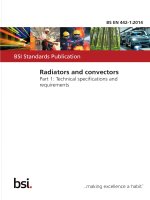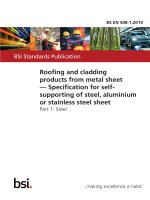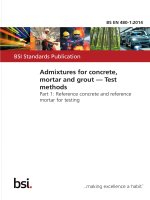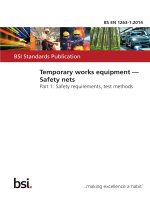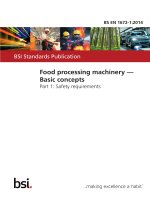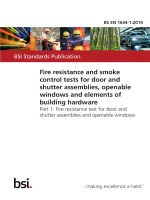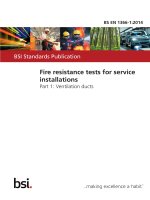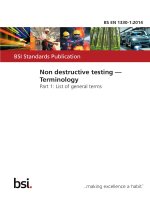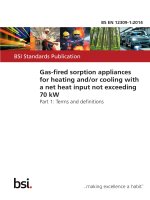Bsi bs en 14654 1 2014
Bạn đang xem bản rút gọn của tài liệu. Xem và tải ngay bản đầy đủ của tài liệu tại đây (1.18 MB, 36 trang )
BS EN 14654-1:2014
BSI Standards Publication
Management and control of
operational activities in drain
and sewer systems outside
buildings
Part 1: Cleaning
BS EN 14654-1:2014
BRITISH STANDARD
National foreword
This British Standard is the UK implementation of EN 14654-1:2014.
It supersedes BS EN 14654-1:2005 which is withdrawn.
The UK participation in its preparation was entrusted to Technical
Committee B/505, Wastewater engineering.
A list of organizations represented on this committee can be
obtained on request to its secretary.
This publication does not purport to include all the necessary
provisions of a contract. Users are responsible for its correct
application.
© The British Standards Institution 2014. Published by BSI Standards
Limited 2014
ISBN 978 0 580 75969 7
ICS 93.030
Compliance with a British Standard cannot confer immunity from
legal obligations.
This British Standard was published under the authority of the
Standards Policy and Strategy Committee on 30 June 2014.
Amendments issued since publication
Date
Text affected
BS EN 14654-1:2014
EN 14654-1
EUROPEAN STANDARD
NORME EUROPÉENNE
EUROPÄISCHE NORM
June 2014
ICS 93.030
Supersedes EN 14654-1:2005
English Version
Management and control of operational activities in drain and
sewer systems outside buildings - Part 1: Cleaning
Gestion et contrôle des opérations d'exploitation dans les
réseaux d'évacuation et d'assainissement à l'extérieur des
bâtiments - Partie 1: Nettoyage
Management und Überwachung von betrieblichen
Maßnahmen in Entwässerungssystemen außerhalb von
Gebäuden - Teil 1: Reinigung
This European Standard was approved by CEN on 17 April 2014.
CEN members are bound to comply with the CEN/CENELEC Internal Regulations which stipulate the conditions for giving this European
Standard the status of a national standard without any alteration. Up-to-date lists and bibliographical references concerning such national
standards may be obtained on application to the CEN-CENELEC Management Centre or to any CEN member.
This European Standard exists in three official versions (English, French, German). A version in any other language made by translation
under the responsibility of a CEN member into its own language and notified to the CEN-CENELEC Management Centre has the same
status as the official versions.
CEN members are the national standards bodies of Austria, Belgium, Bulgaria, Croatia, Cyprus, Czech Republic, Denmark, Estonia,
Finland, Former Yugoslav Republic of Macedonia, France, Germany, Greece, Hungary, Iceland, Ireland, Italy, Latvia, Lithuania,
Luxembourg, Malta, Netherlands, Norway, Poland, Portugal, Romania, Slovakia, Slovenia, Spain, Sweden, Switzerland, Turkey and United
Kingdom.
EUROPEAN COMMITTEE FOR STANDARDIZATION
COMITÉ EUROPÉEN DE NORMALISATION
EUROPÄISCHES KOMITEE FÜR NORMUNG
CEN-CENELEC Management Centre: Avenue Marnix 17, B-1000 Brussels
© 2014 CEN
All rights of exploitation in any form and by any means reserved
worldwide for CEN national Members.
Ref. No. EN 14654-1:2014 E
BS EN 14654-1:2014
EN 14654-1:2014 (E)
Contents
Page
Foreword ..............................................................................................................................................................4
Introduction .........................................................................................................................................................5
1
Scope ......................................................................................................................................................6
2
Normative references ............................................................................................................................6
3
3.1
3.2
3.3
Terms and definitions ...........................................................................................................................6
General ....................................................................................................................................................6
Deposits ..................................................................................................................................................7
Cleaning methods ..................................................................................................................................7
4
General ....................................................................................................................................................8
5
5.1
5.2
Cleaning plan ...................................................................................................................................... 11
Introduction ......................................................................................................................................... 11
Cleaning aims...................................................................................................................................... 11
6
6.1
6.2
6.3
6.4
6.5
6.5.1
6.5.2
6.5.3
6.5.4
6.5.5
6.5.6
Preparation of cleaning programme ................................................................................................. 12
Introduction ......................................................................................................................................... 12
Review of the cleaning plan ............................................................................................................... 12
Investigation ........................................................................................................................................ 12
Assessment ......................................................................................................................................... 13
Develop the programme ..................................................................................................................... 14
Introduction ......................................................................................................................................... 14
Specification of objectives ................................................................................................................ 14
Develop options .................................................................................................................................. 15
Assess technical feasibility of solutions ......................................................................................... 15
Select optimum solution .................................................................................................................... 15
Producing the programme ................................................................................................................. 16
7
7.1
7.2
7.3
7.4
7.5
7.5.1
7.5.2
7.5.3
7.6
7.6.1
7.6.2
7.6.3
Preparation of the project specification ........................................................................................... 16
Introduction ......................................................................................................................................... 16
Review of the project description and project objectives .............................................................. 16
Investigation ........................................................................................................................................ 16
Assessment ......................................................................................................................................... 17
Drafting the project specification...................................................................................................... 17
Prepare detailed options .................................................................................................................... 17
Select optimal solution ...................................................................................................................... 18
Prepare project specification ............................................................................................................ 18
Performance indicators ...................................................................................................................... 19
Introduction ......................................................................................................................................... 19
Indicators for the assessment of the work quality .......................................................................... 19
Indicators for the assessment of the effectiveness of the project or programme ...................... 19
8
8.1
8.2
8.3
8.4
8.5
8.6
8.7
8.8
8.9
Implementation of projects ................................................................................................................ 20
Introduction ......................................................................................................................................... 20
Select cleaning technique .................................................................................................................. 20
Selection of contractor ....................................................................................................................... 21
Supervision of the works ................................................................................................................... 21
Flow control......................................................................................................................................... 22
Traffic management ............................................................................................................................ 22
Waste management ............................................................................................................................ 23
Training ................................................................................................................................................ 23
Health and safety ................................................................................................................................ 23
2
BS EN 14654-1:2014
EN 14654-1:2014 (E)
8.10
8.11
Environmental impact ......................................................................................................................... 23
Cleaning report .................................................................................................................................... 24
9
9.1
9.1.1
9.1.2
9.2
Measurement of conformity ............................................................................................................... 25
Measuring conformity with the project specification ...................................................................... 25
Measuring conformity ......................................................................................................................... 25
Non-conformities ................................................................................................................................. 25
Post project appraisal ......................................................................................................................... 25
10
Review of programme and plan ......................................................................................................... 26
Annex A (informative) Example of cleaning report form ............................................................................. 27
Annex B (informative) Cleaning methods ..................................................................................................... 28
B.1
General ................................................................................................................................................. 28
B.2
Jetting ................................................................................................................................................... 28
B.3
Jetting with suction ............................................................................................................................. 28
B.4
Winching............................................................................................................................................... 28
B.5
Rodding ................................................................................................................................................ 29
B.6
Remote controlled equipment ............................................................................................................ 29
B.7
Flushing ................................................................................................................................................ 29
B.8
Cleaning balls/scouring plates .......................................................................................................... 29
B.9
Manual or mechanical excavation ..................................................................................................... 29
Bibliography ...................................................................................................................................................... 30
3
BS EN 14654-1:2014
EN 14654-1:2014 (E)
Foreword
This document (EN 14654-1:2014) has been prepared by Technical Committee CEN/TC 165 “Waste water
engineering”, the secretariat of which is held by DIN.
This European Standard shall be given the status of a national standard, either by publication of an identical
text or by endorsement, at the latest by December 2014, and conflicting national standards shall be withdrawn
at the latest by December 2014.
Attention is drawn to the possibility that some of the elements of this document may be the subject of patent
rights. CEN [and/or CENELEC] shall not be held responsible for identifying any or all such patent rights.
This document supersedes EN 14654-1:2005.
EN 14654 “Management and control of operational activities in drain and sewer systems outside buildings”
contains the following parts:
—
Part 1: Cleaning;
—
Part 2: Rehabilitation.
Other parts, dealing with other activities, may be added later.
In drafting this part of EN 14654, account has been taken of other available standards, in particular EN 752
“Drain and sewer systems outside buildings” and EN 13508 “Investigation and assessment of drain and sewer
systems outside buildings”.
According to the CEN-CENELEC Internal Regulations, the national standards organizations of the following
countries are bound to implement this European Standard: Austria, Belgium, Bulgaria, Croatia, Cyprus, Czech
Republic, Denmark, Estonia, Finland, Former Yugoslav Republic of Macedonia, France, Germany, Greece,
Hungary, Iceland, Ireland, Italy, Latvia, Lithuania, Luxembourg, Malta, Netherlands, Norway, Poland, Portugal,
Romania, Slovakia, Slovenia, Spain, Sweden, Switzerland, Turkey and the United Kingdom.
4
BS EN 14654-1:2014
EN 14654-1:2014 (E)
Introduction
This European Standard deals with the management and control of cleaning operations in drain and sewer
systems. Cleaning operations are a part of the general management of drain and sewer systems.
The employing authority sets the aims of the cleaning operations, expressed in terms of the end result,
necessary to achieve the performance requirements for the drain and sewer system (see EN 752), and
develops a strategy to meet these aims. The employing authority also produces a specification for cleaning
operations taking account of the aims and the strategy, and including indicators for controlling the quality of
the results.
Before commencing cleaning operations, the employing authority should have a thorough knowledge of the
drain and sewer system and an assessment of the hydraulic conditions and other relevant factors in order to
understand the type and frequency of cleaning necessary (see EN 752). However, it is sometimes necessary
to carry out some work in order to obtain this knowledge.
On completion, a report of the cleaning operations is produced, providing information on the works, on any
difficulties encountered and any anomalies.
This information is used to improve the management of drain and sewer systems.
5
BS EN 14654-1:2014
EN 14654-1:2014 (E)
1
Scope
This European Standard establishes the general principles for the management and control of operational
activities in drain and sewer systems outside buildings and specifies requirements for development and
implementation of work programmes, and the selection of techniques.
This European Standard covers the management and control of cleaning.
It is applicable to drain and sewer systems, which operate essentially under gravity, from the point where
wastewater leaves a building, roof drainage system, or paved area, to the point where it is discharged into a
treatment works or receiving water body. Drains and sewers below buildings are included provided that they
do not form part of the drainage system of the building.
2
Normative references
The following documents, in whole or in part, are normatively referenced in this document and are
indispensable for its application. For dated references, only the edition cited applies. For undated references,
the latest edition of the referenced document (including any amendments) applies.
EN 752:2008, Drain and sewer systems outside buildings
EN 1829-1:2010, High pressure water jet machines - Safety requirements - Part 1: Machines
EN 1829-2:2008, High-pressure water jet machines - Safety requirements - Part 2: Hoses, hose lines and
connectors
EN 13508-1:2012, Investigation and assessment of drain and sewer systems outside buildings - Part 1:
General Requirements
EN ISO 14001, Environmental management systems - Requirements with guidance for use (ISO 14001:2004)
3
Terms and definitions
For the purposes of this document, the following terms and definitions apply.
3.1 General
3.1.1
cleaning activities
removal or partial removal of settled deposits, attached deposits, roots and other obstacles from a drain or
sewer system
3.1.2
degree of cleaning
extent to which complete removal of deposits is achieved
3.1.3
employing authority
organization that owns or is responsible for the management of a drain or sewer system
3.1.4
removal
extraction of deposits after collecting at the working area or the intentional use of the flow in the drain or sewer
to carry the re-entrained solids to a specified point of extraction
6
BS EN 14654-1:2014
EN 14654-1:2014 (E)
3.1.5
self-cleansing
ability of the flow in a drain or sewer to carry away solid particles which would otherwise be deposited in the
pipe
[SOURCE: EN 16323: 2014, 2.2.1.13]
3.1.6
supernatant liquor
liquor in a tank lying above the deposited solids
[SOURCE: EN 16323:2014, 2.1.2.16]
3.2 Deposits
3.2.1
attached deposits
material attached to the wall of elements of the drain or sewer system by physical or chemical bonding
3.2.2
settled deposits
material deposited by gravity in the invert or benching of elements of the drain or sewer system
3.3 Cleaning methods
3.3.1
cleaning ball
spherical device, having an indented surface, designed to be carried through a drain or sewer by the flow to
facilitate removal of sediments
[SOURCE: EN 752:2008, 3.9]
3.3.2
combined jetting
simultaneous use of high-pressure water jetting equipment together with a suction action, to remove
obstructions or sediments from drains or sewers
[SOURCE: EN 16323:2014, 2.2.1.10]
3.3.3
flushing
use of a temporary and substantially increased flow to facilitate the removal of obstructions or sediments from
drains or sewers
[SOURCE: EN 16323: 2014, 2.2.1.16]
3.3.4
jetting
use of water under defined conditions of pressure and flow through a nozzle
[SOURCE: EN 16323:2014, 2.2.1.18]
3.3.5
rodding
use of appropriate device on the end of flexible rods to facilitate the removal of obstructions (or sediments)
from drains or sewers
[SOURCE: EN 16323: 2014, 2.2.1.11]
7
BS EN 14654-1:2014
EN 14654-1:2014 (E)
3.3.6
scouring plate
device used to clean a drain or sewer by concentrating the flow into a small cross section thereby increasing
the flow velocity
3.3.7
winching
use of a device pulled through a drain or sewer to facilitate removal of sediments (or obstructions)
[SOURCE: EN 16323:2014, 2.2.1.12]
4
General
EN 752:2008, Clause 6, outlines the process for preparation and implementation of an integrated drain and
sewer system management plan which includes, at a strategic level, plans for the rehabilitation and
maintenance of the drain and sewer system. The amount of detail in these plans in the integrated drain and
sewer system plan can vary. A maintenance plan should include a cleaning plan where cleaning activities are
necessary.
Cleaning activities in drains and sewers can be carried out pro-actively, to prevent problems occurring or to
clean a drain or sewer before particular operations (e.g. an inspection or renovation work) or reactively in
response to problems that have occurred.
The requirements for pro-active cleaning can be identified through a rehabilitation plan, a maintenance plan
involving periodic monitoring or as part of an integrated sewer system management plan in accordance with
EN 752. Consideration shall also be given to the feasibility of preventing deposition of sediments for example
by rehabilitation of the sewer.
This European Standard sets out a process for implementing the cleaning activities in the integrated drain and
sewer system management plan. The process is based on a staged application of the process outlined in
Figure 1.
NOTE
Based on EN 752:2008, Figure 5.
Figure 1 — Integrated Sewer System Management Process
8
BS EN 14654-1:2014
EN 14654-1:2014 (E)
The integrated sewer system management process is applied successively to develop a cleaning programme
based on the integrated sewer system management plan. The programme outlines a series of discrete
projects to implement the plan. Following this, the integrated sewer system management process is then used
to produce a detailed specification for each of these projects in the programme. Finally, following the
implementation of each project, the cleaning programme and the integrated sewer system management plan
are reviewed and updated where necessary. The performance requirements should be in accordance with
EN 752:2008, 5.2.
At each stage further investigation and assessment is carried out in accordance with EN 13508-1.
This staged process is summarized in full in Figure 2. The extent and detail of these stages should be
determined by the characteristics of the individual systems. According to the specific local conditions, stages
may be consolidated or, if they are not necessary, omitted.
9
BS EN 14654-1:2014
EN 14654-1:2014 (E)
Figure 2 — Summary of the sewer cleaning management and control process
10
BS EN 14654-1:2014
EN 14654-1:2014 (E)
5
Cleaning plan
5.1 Introduction
An integrated sewer system management plan prepared in accordance with EN 752:2008, Clause 6, includes:
—
new development plan;
—
rehabilitation plan;
—
operational plan;
—
maintenance plan.
Cleaning activities are one aspect of the maintenance plan, as part of an integrated sewer system
management plan. A maintenance plan, dealing with cleaning activities should be in place for the drain and
sewer system prior to carrying out major programmes of sewer cleaning. However, this is not always possible
if works are required urgently (e.g. in response to a sewer failure).
It is not necessary for the plan to include detailed descriptions of the solutions. It may include only general
descriptions of the approaches to be taken.
5.2 Cleaning aims
The principal aims of carrying out cleaning work can include:
a)
Pro-active cleaning
—
to ensure that the performance of the drain or sewer system is acceptable;
—
to prolong the operational life and maintain the value of the asset;
—
to control septicity to reduce associated odour, health and potential corrosion problems;
—
to limit polluting discharges into receiving water bodies;
—
to enable inspection or renovation of the drain or sewer system;
—
to optimize the effectiveness of key components of the system at critical times (e.g. prior to heavy rain
seasons, busy periods in tourist sites);
—
to facilitate inspection.
b)
Reactive cleaning
—
to remove a blockage in order to restore the flow;
—
to restore the function of the drain or sewer system;
—
to remove sediments in order to reduce septicity and odour problems.
The nature of the aim can determine the degree of cleaning necessary.
11
BS EN 14654-1:2014
EN 14654-1:2014 (E)
6
Preparation of cleaning programme
6.1 Introduction
The starting point for the preparation of the cleaning programme is the maintenance plan produced in
accordance with EN 752:2008, Clause 6, and the performance requirements produced in accordance with
EN 752:2008, Clause 5.
The maintenance plan does not generally contain the necessary detail to proceed directly to the production of
the cleaning specification. The cleaning programme defines a series of projects, in line with the integrated
sewer system management plan, to ensure that the drain and sewer system meets the performance
requirements. The cleaning programme should define the objectives for each project in sufficient detail so that
a project specification can then be produced in accordance with Clause 7.
The preparation of the cleaning programme involves:
a)
review of the cleaning plan (see 6.2) to ensure it is still current and to establish what further investigation
is required to develop the programme;
b)
further investigation (see 6.3) to provide the information necessary for the more detailed assessment;
c)
more detailed assessment (see 6.4) to identify further detail of the performance deficiencies that the
programme needs to address;
d)
develop the programme (see 6.5) setting the scope and objectives for each of the projects.
All stages of the preparation of the cleaning programme shall take account of the health and safety principles
set out in EN 752:2008, Clause 7.
6.2 Review of the cleaning plan
A review should be undertaken of the cleaning aspects of the maintenance plan within the integrated sewer
system management plan. This should include:
a)
ensuring the performance requirements used in the preparation of the integrated sewer system
management plan are still current;
b)
checking that any assumptions regarding projected timescales included in the plan for new developments
or other changes to the sewer system are still valid;
c)
identifying where further investigation and assessment is required in order to develop the programme of
works.
If there have been any changes then the plan should be updated.
6.3 Investigation
The investigation of the drain and sewer system shall be carried out in accordance with EN 752:2008,
Clause 6, and EN 13508-1:2012, Clause 5.
The location of the sections of drains and sewers where proactive cleaning is to be carried out and the
assessment of the cleaning frequencies shall be based on:
a)
an understanding of the characteristics and structural condition of the drain and sewer system;
b)
an analysis of its performance;
12
BS EN 14654-1:2014
EN 14654-1:2014 (E)
c)
a review of the available information which may include the performance of similar systems elsewhere.
The different sections of the sewer shall be described according to the information collected in order to
optimize the cleaning programme.
The scope of the investigations necessary to produce the cleaning programme will depend on the extent of
the investigations carried out during the preparation of the integrated sewer system management plan. A
review should be undertaken of the information available. The review should include:
d)
inventory data
1)
type of effluent (wastewater, surface water, combined sewage or specific effluents);
2)
sewer characteristics (shape, size, slope, depth, material, etc.), presence and characteristics of
combined sewer overflows and other ancillaries;
3)
characteristics of the location of the sewer (e.g. aquifer protection zones, ground water level, trees,
proximity of receiving water bodies);
e)
condition information from inspection reports (e.g. visual inspection reports, CCTV reports, sediment
measurements);
f)
data on flows from measurements or the results of hydraulic models;
g)
records of past cleaning (e.g. location of areas of persistent operational problems); and
h)
performance data (e.g. flooding, sewer blockages, collapses, odours, septicity problems, premature
operation of combined sewer overflows, etc.).
Where there is insufficient information available to plan the cleaning programme, a programme of
investigations shall be carried out to obtain the necessary information.
An example report form is given in Annex A.
Investigations should be carried out where further information is needed in order to produce the cleaning
programme.
Examples can include:
—
further inspection in parts of the system where the original assessment was based only on sample
inspections;
—
the use of an appropriate sewer flow simulation model;
—
more detailed studies of the impact of any discharges on receiving waters bodies.
Details of investigation techniques for drains and sewers are described in EN 13508-1.
6.4 Assessment
The assessment should identify the location of those components of the drains and sewer system where
proactive or reactive cleaning is to be carried out. This shall be based on:
a)
the effect of the deposits on the performance of the system;
b)
the sources of such deposits;
13
BS EN 14654-1:2014
EN 14654-1:2014 (E)
c)
the typology of the drain or sewer;
d)
the nature of the effluent.
The performance of the drain or sewer systems shall be assessed in accordance with EN 13508-1:2012,
Clause 6, using the results of the investigation (see 6.3). The assessments carried out during the preparation
of the integrated sewer system management plan should be reviewed and updated in the light of any new
information identified during the investigations. The performance at each planning horizon shall be compared
to the performance requirements to identify the needs for cleaning.
Where inspection is used to determine the current levels of sediment, the effect of the movement of sediment
in dunes, leaving some parts of the pipe clear while other localized parts of the sewer have significant
deposits, should be considered. However, localized sediments may also indicate the presence of an obstacle.
The typology of drains and sewers can be identified as:
—
type 1: drains and sewers which are self-cleansing, where proactive cleaning is exceptional;
—
type 2: drains and sewers which are not completely self-cleansing, where proactive cleaning could be
beneficial, the cleaning frequencies depending on the rate of sediment accumulation;
—
type 3: drains and sewers with localized problems, which require frequent cleaning.
The typology can change over time.
Other elements of the sewer system, for example sewer connections, gullies, silt traps, inverted siphons,
pumping stations can also require cleaning.
This analysis is carried out using available information including the results of the specific investigations
carried out to develop the programme (see 6.3).
The results of the assessment should be checked with the assessment made during the production of the
integrated sewer system management plan and if there are significant differences the plan should be reviewed
to ensure that it is still valid.
6.5 Develop the programme
6.5.1
Introduction
The cleaning programme comprises a number of projects which together shall meet the objectives. Where
cleaning forms part of the integrated sewer system management plan, a cleaning programme should be
developed. The cleaning programme should define the scope and objectives of each project in the programme
and the phasing of the projects including the relationship to any external constraints such as budgets, and
interactions with other programmes. The programme shall take account of the safety principles in
EN 752:2008, Clause 7. The potential of education to improve user behaviour or enforcement of permits for
industrial wastewater should be considered.
A cleaning programme shall:
—
identify optimum frequencies for pro-active cleaning operations;
—
maintain or reduce the number of reactive cleaning operations to an acceptable level.
6.5.2
Specification of objectives
The cleaning objectives should be established in accordance with the cleaning aim. These should be
expressed as a performance requirement, for example:
14
BS EN 14654-1:2014
EN 14654-1:2014 (E)
a)
to remove settled and/or attached deposits to a prescribed amount, (for example remove completely or to
a maximum depth); or
b)
to restore the flow capacity in a pipe to the design capacity; or
c)
to limit the build-up of sediments to a prescribed level; or
d)
to limit the deposits to existing levels (maintaining a balance in the sediment movement); or
e)
to limit the build-up of deposits so that flooding is limited to prescribed frequencies; or
f)
to remove sufficient deposits to avoid blockages; or
g)
to remove sufficient sediments to allow an inspection to take place or to facilitate renovation or repair;
h)
to remove bio-films (for example from rising mains to reduce septicity, or from heat exchangers).
6.5.3
Develop options
There are a number of possible cleaning approaches, these include the following:
—
periodic cleaning (cleaning according to fixed time intervals);
—
monitored periodic cleaning (cleaning according to time interval, the subsequent time interval is updated
according to the depth of deposits prior to previous cleaning);
—
planned inspection (by CCTV or other method) and cleaning (inspection at intervals in order to determine
when deposits have reached a threshold level for cleaning);
—
specific cleaning before other works such as CCTV inspection, rehabilitation operations, etc.;
—
reactive cleaning - in those sections of drains and sewers which are normally self-cleansing;
—
enforcement action – enforcing discharge permits or discharge regulations to prevent discharge of
unsuitable materials into the drain or sewer system.
Where frequent cleaning is required, or where the consequences of sediment accumulation are severe,
consideration should be given to the feasibility of carrying out rehabilitation works to prevent the accumulation
of sediments.
6.5.4
Assess technical feasibility of solutions
The options developed in 6.5.2 should first be assessed to establish the extent to which they will meet the
cleaning objectives and minimum performance requirements, and whether it would be feasible to implement
them, for example the feasibility of increasing capacity by sewer cleaning.
All options that meet the minimum performance requirements and that are technically feasible to implement
should be taken forward to the next stage.
6.5.5
Select optimum solution
The selection of the most appropriate option shall then take account of a wide range of costs and benefits of
each of the options. These should take account of the extent (if any) to which any option would result in the
system achieving more than the minimum performance requirements or providing additional capacity beyond
that currently anticipated.
15
BS EN 14654-1:2014
EN 14654-1:2014 (E)
Criteria for assessing the costs and benefits of different options in order to select the optimum solution are
given in EN 752:2008, 6.4.3.
6.5.6
Producing the programme
The programme should specify:
a)
the cleaning objectives (see 6.5.2);
b)
the approach to be adopted (see 6.5.3);
c)
location and length of the sewers to be cleaned or inspected;
d)
nature of the deposits anticipated to be removed (for example intruding roots, sediments, obstacles).
7
Preparation of the project specification
7.1 Introduction
The project specification shall contain all the information, including any drawings, necessary to carry out the
project.
The starting point for the preparation of the project specification is the project description and project
objectives in the sewer cleaning programme produced in accordance with Clause 6 and the performance
requirements produced in accordance with the EN 752:2008, Clause 5.
Further information is still likely to be required to carry out the detailed design and produce the specification.
The preparation of the project specification involves:
—
review of the project description and project objectives;
—
further investigation;
—
further assessment (if necessary);
—
producing the project specification.
All stages of the preparation of the project specification shall take account of the health and safety principles
set out in EN 752:2008, Clause 7.
7.2 Review of the project description and project objectives
The project description and objectives as set out in the sewer cleaning programme should be reviewed to
ensure it is still current. Any related new developments or other utility works should be reviewed. Where there
have been any changes in the nature or the timing of other works which might impact on the project or its
phasing the programme should be revised.
The information available should be reviewed to determine what further investigations are necessary in order
to produce the project specification.
7.3 Investigation
An investigation should be carried out to determine the following:
—
16
the extent of the deposits or obstructions including deposits in lateral connections to the sewer;
BS EN 14654-1:2014
EN 14654-1:2014 (E)
—
the nature of the deposits expected (e.g. grease, sand);
—
whether the deposits are the cause (wholly or partially) of any reported performance problems;
—
the amount of deposits which need to be removed to restore acceptable performance having regard to
the likely rate of re-deposition following cleaning;
—
the structural condition of the drain or sewer and the type of material;
—
other information that could affect the feasibility of sewer cleaning work.
The investigation should be carried out using the existing data available. Further investigation can be
necessary.
7.4 Assessment
EN 13508-1 gives guidance on the assessment of existing drain and sewer systems. The assessment should
be sufficiently detailed to allow decisions to be taken on the solutions for the project.
Following the completion of the assessment, the project objectives should be reviewed to ensure that they are
still valid.
7.5 Drafting the project specification
7.5.1
Prepare detailed options
Options should be developed for the pipeline lengths to be cleaned and the amount of deposit that need to be
removed. The feasibility of these options should be evaluated taking into account:
a)
the nature of the deposits or obstacles to be removed;
b)
the size of the drain or sewer;
c)
the range of water depths and the flow regimes within the drain or sewer;
d)
restrictions on the access, including
1)
traffic restrictions,
2)
the availability of suitable manholes or inspection chambers,
3)
the need for off-road vehicles and their suitability to the site conditions,
4)
the weight of the vehicle and the risk of the damage to the drain or sewer,
5)
land ownership;
e)
the structural condition and the type of material of the drain or sewer and its susceptibility to deterioration
due to damage through cleaning;
f)
the extent to which they meet the cleaning aims;
g)
the risk the sewer cleaning method will contribute to early CSO operation or flooding.
17
BS EN 14654-1:2014
EN 14654-1:2014 (E)
7.5.2
Select optimal solution
The options found to be technically feasible should be compared to identify the optimal solution in accordance
with the procedure described in EN 752:2008, 6.4.3.
7.5.3
Prepare project specification
For the selected option, a description of the works shall be produced to provide all the information necessary
for the cleaning activities.
The information provided in the project specification can include:
a)
the objective of the cleaning;
b)
the location and extent of the section to be cleaned (e.g. drawing);
c)
the location of the access points (e.g. manholes or inspection chambers) and the distance between them;
d)
restrictions on access to the site of the manhole or inspection chamber (e.g. traffic restrictions, the need
for off road vehicles, land ownership etc.);
e)
restriction on access into or within the manhole or inspection chamber (e.g. the need for special lifting
equipment or diameter of the manhole or inspection chamber);
f)
the depth of the manhole or inspection chamber;
g)
the type of deposits expected;
h)
the size of the drain or sewer;
i)
any known hazards (including hazards from trade effluents, drop pipes, automatic flushing devices etc.);
j)
the water depth and flows in the drain or sewer in various conditions;
k)
environmental restrictions such as noise, odours, etc.;
l)
whether there is danger of a direct spill from the sewer into a receiving water body;
m) traffic management requirements;
n)
restrictions on working methods;
o)
restrictions on temporary stopping where this could cause flooding or pollution;
p)
the locations of pumping installations or other structures which could be adversely affected by cleaning
operations;
q)
whether and where deposits are to be removed from the drain or sewer;
r)
restrictions on the disposal of deposits and supernatant liquor (see 8.7);
s)
water supply points (location, the nature of that supply and number);
t)
welfare facilities required on site for the use of operatives engaged on the cleaning works;
u)
information available in relation to the waste material to be removed by the cleaning work;
18
BS EN 14654-1:2014
EN 14654-1:2014 (E)
v)
the anticipated volumes of material, if known, to be removed as part of the cleaning operation;
w) public safety issues that could arise from the works.
7.6 Performance indicators
7.6.1
Introduction
Performance indicators should be selected to determine whether the project has
a)
been carried out in accordance with the project specification, and
b)
achieved the objectives set out in the sewer cleaning programme or project.
For each site, it is advisable to adapt the indicator to show without ambiguity whether the required
performance has been achieved. A performance indicator should be clearly defined, simple and easy to use. It
should be based on measurable parameters such as the depth of deposits (where the location can be visually
inspected), the mass or volume of the material removed. Performance indicators should be used to measure
conformity of the completed project (see Clause 9).
In certain cases, statistical indicators of the amount of material removed can be used. It could therefore be
possible to allow, for example, a predetermined number of obstructions per unit length, as a satisfactory
degree of cleaning.
7.6.2
Indicators for the assessment of the work quality
The results required either immediately after cleaning has taken place, or on a continuing basis, shall be
clearly described in the specification, to ensure that the cleaning objectives are achieved.
Performance indicators should be selected in relation to each of the cleaning objectives.
Examples of indicators can include:
—
re-establishing free flow following reactive cleaning;
—
number of complaints concerning odours, blockages, flooding or pollution from a sewer length after proactive cleaning;
—
measurement of sediment depths at a sample of sections which were cleaned;
—
percentage of sediment depth compared to the diameter of the drain.
7.6.3
Indicators for the assessment of the effectiveness of the project or programme
Examples of indicators can include:
—
percentage of the total length of drain or sewer cleaned pro-actively per year;
—
percentage of the total length of drain or sewer cleaned reactively per year;
—
number of emergency cleaning operations carried out per kilometre of sewer each year;
—
number of complaints concerning odours, blockages, flooding or pollution from a sewer length after proactive cleaning;
—
volume or weight of sediments removed per kilometre of sewer cleaned.
19
BS EN 14654-1:2014
EN 14654-1:2014 (E)
8
Implementation of projects
8.1 Introduction
The implementation of the project shall be carried out in accordance with the principles set out in
EN 752:2008, Clause 11. Personnel carrying out the work shall have appropriate training in accordance with
EN 752:2008, Clause 13.
The cleaning work should generally be carried out in such a manner that coarse material and debris is not
allowed to discharge into the downstream sewer system. In some cases, it is possible to remove deposits at
the wastewater treatment plant or other appropriate location. Deposits shall be removed from the drain or
sewer system.
Where all the drains or sewers in an area are being cleaned, work should generally start with those sewers
near the head of the system and continue downstream.
Where a supply of water is required, measures shall be taken to avoid contamination of any drinking water
supply and to avoid unacceptable impact of the pressure supplied to other users. Where high pressure water
jetting cleaning methods are to be employed the use of equipment capable of recycling the supernatant liquor
decanted from the deposits removed should be considered. In addition, the use of non-potable water sources
should also be considered.
Where unexpected pollutants are found, the cleaning work should be stopped, and arrangements made to
avoid dispersing the pollution. The employer will be informed to agree what to do next.
Information on cleaning methods is given in Annex B.
8.2 Select cleaning technique
When selecting the cleaning method and equipment the following considerations should be taken into
account:
a)
the nature of the deposits or obstacles to be removed;
b)
the shape, size and depth of the drain or sewer;
c)
the range water depths and the flow regimes within the drain and sewer;
d)
the distance from the manhole or inspection chamber to the furthest point to be cleaned;
e)
restrictions on the access to the manhole or inspection chamber, including traffic restrictions, the need for
off-road vehicles, land ownership;
f)
whether access is available from the downstream manhole or inspection chamber;
g)
whether the access from the manhole or inspection chamber to the furthest point to be cleaned is only
through plain (straight) pipe or whether it is through bends or an interceptor trap;
h)
the type of material used in the construction of the drain or sewer and its susceptibility to damage through
cleaning;
i)
the structural condition of the drain or sewer and its susceptibility to deterioration due to damage through
cleaning;
j)
environmental criteria such as noise, odours, the risk of discharge to the environment, etc.
Further information on the different cleaning methods available is given in Annex B.
20
BS EN 14654-1:2014
EN 14654-1:2014 (E)
8.3 Selection of contractor
The work can be carried out directly by the employing authority (e.g. the owner or operator of the system) or
by a contractor.
The Public Procurement Directive (Directive 2004/18/EC [2]) can apply to the selection of contractors.
The selection of a contractor should take into account a number of factors including:
a)
the qualifications of the contractor, including:
1)
technical competence and experience;
2)
availability of adequate equipment and personnel;
3)
health and safety procedures;
4)
quality management systems in place;
5)
environmental management systems;
6)
financial stability;
7)
licence to work in the country.
b)
price.
c)
waste management capabilities.
d)
The impact of the proposed method of working including:
1)
the proposed resources, including:
i)
personnel (including management);
ii)
equipment;
iii) materials.
2)
the management of risks including minimizing:
i)
risks to the health and safety of operatives on site and of the public;
ii)
environmental risks.
3)
contract strategy – e.g. a single management contractor with subcontractors, or division of the work
between different contracts.
4)
social disruption – the disruption to local residents and other members of the public.
8.4 Supervision of the works
Supervision of the contractor by the employing authority or their representative should include the following:
a)
ensuring that the contracting company has adequate internal management procedures;
b)
competency of the contractor's supervisors and license (if required);
21
BS EN 14654-1:2014
EN 14654-1:2014 (E)
c)
compliance of the works with the specification;
d)
checking the adequacy of resources and methods of working;
e)
the verification of health and safety compliance;
f)
progress of the works in accordance with the project specification;
g)
reporting, auditing and documentation of test procedures, test results and performance indicators;
h)
valuation of works and approval of payments;
i)
certification of the satisfactory completion of the works;
j)
ensuring that records of the works are produced;
k)
monitoring the volumes and type of material removed from the sewer or drain including checking that soil
from around the pipe is not entering the system.
In addition the contractor shall supervise the works themselves, including:
l)
checking the adequacy of resources and methods of working;
m) progress of the works in accordance with the project specification;
n)
reporting the volumes and type of material removed from the sewer or drain;
o)
dealing with unforeseen incidents;
p)
cost control;
q)
health and safety coordination (the Temporary and Mobile Sites Directive (Directive 92/57/EEC [1]) can
apply).
8.5 Flow control
Where work is being carried out in existing drain and sewer systems, consideration should be given to
measures to control the flow where necessary. The need for such measures will depend on the method used
and can include:
a)
use of temporary stoppers to control the flow for short periods;
b)
use of temporary pumps in association with temporary stoppers to pump the flow past the works;
c)
temporary diversion of the flow.
The selection of the appropriate approach will depend on the frequency and magnitude of expected flows,
having regard to the expected weather and other factors.
8.6 Traffic management
Where works are carried out in roads, the effect of the works on the traffic should be considered and
measures taken to limit the impact; for example by local traffic control measures such as temporary traffic
signals, or installation of traffic diversions via alternative routes. Consideration should be given to providing
road users, local residents and businesses etc. advance notification of the cleaning works.
22
BS EN 14654-1:2014
EN 14654-1:2014 (E)
8.7 Waste management
Measures should be taken to minimize the impact of wastes from the cleaning works. The waste management
approach should be in accordance with the following hierarchy:
a)
measures should be taken to minimize the amount of waste produced for example by dewatering;
b)
where waste is produced measures should be taken to recycle as much of the waste as practicable;
c)
where it is not possible to recycle the waste, consideration should be given to the use of the waste for
energy recovery;
d)
where none of the options is possible, the disposal of the waste should take account of the environmental
impact.
Where possible, deposits should be recycled in accordance with the principles of sustainability.
Any of these disposal methods can include treatment of the waste.
Inappropriate disposal of deposits can cause environmental damage and endanger public health, and the
disposal of deposits can be subject to national legislation. Any restrictions on the disposal of the deposits shall
be defined in the contract.
8.8 Training
Training requirements for work in drain and sewer systems are described in EN 752:2008, Clause 13.
Training requirements essentially depend on chosen techniques and materials.
The contractor shall ensure that personnel working on the site are adequately trained in respect of the
particular cleaning method used.
Personnel at all levels taking part in sewer cleaning activities shall be made aware of all specific risks of such
activity (see also 8.1).
8.9 Health and safety
The works shall be carried out in accordance with the health and safety principles described in EN 752:2008,
Clause 7. Further guidance on health and safety is given in EN 752:2008, Annex D. In addition to the hazards
generally associated with work in drains and sewers there are some special hazards associated with some of
the equipment used for sewer cleaning. High-pressure water jetting machines shall comply with the
requirements of EN 1829-1 and EN 1829-2.
The main part of the sewer cleaning operations comprises work on drains and sewers and in confined spaces.
In addition, there can be hazards related to the specific cleaning method.
The contractor shall identify the health and safety risks associated with the proposed cleaning works and
provide the necessary mitigation of those risks.
Drain and sewer cleaning sites are frequently close to traffic.
8.10 Environmental impact
The environmental impact shall be taken into account. Environmental management procedures are described
in EN ISO 14001.
23
